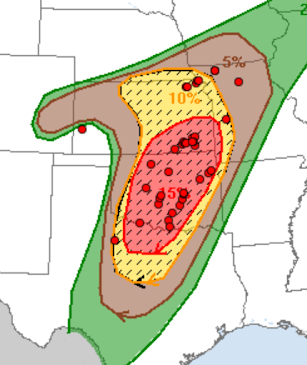Meteorologists Save Lives!
Fifty years ago this month (April 3 and 4, specifically), a rash of 147 tornadoes struck the United States east of the Mississippi River. Inconsistent radar coverage, slow communications, and lack of meteorological knowledge pertaining to tornado formation meant the tornado warnings were often late or of poor quality. As a result, 335 people lost their lives. Damage, in today’s dollars, reached $5.3 billion.
Friday and Saturday, 152 (preliminary number) tornadoes occurred. The death toll? Just four.
While those deaths are unspeakable tragedies for the friends and families of the deceased, the fact is that the modern tornado warning system saved more than 300 lives.
Fifty years ago, the University of Oklahoma storm chase program (along with subsequent field research programs), which has yielded so much practical knowledge about the development tornadoes, was just two years old. The high-speed weather wire began in 1988. The network of Doppler radars was installed in the 1990’s but it took us about a decade to understand how to optimize its use. Dual-polarization, which allows us to see lofted debris, is about a decade old. In the past five years, “convection-allowing models” have come to be used. And, most importantly, meteorologists and meteorology students have been taught how to put this firehose of new information to practical use.
The modern tornado warning program is a public-private sector team effort. The National Weather Service (NWS) has built the meteorological infrastructure. Their infrastructure is supplemented by privately owned weather stations, radars, lightning networks and even satellites in space. The data collected is provided to NWS and private sector weather companies which analyze it and run computer models which simulate future weather conditions. That database is used by the NWS to provide forecasts and warnings to the public and by private sector meteorologists to provide forecasts and warnings to their customers. For example, television meteorologists will take the NWS warnings and supplement that information with their own radars, storm chasers, and cloud cameras to make his or her warnings as timely and as accurate as they can be.
It is not just forecasts for the public. Air Force forecasters came to the same conclusions as the NWS and billions of dollars of planes were flown out of harm’s way from McConnell and Tinker AFB's. Businesses took other precautions to avert loss of life and property damage that are too long to list here.
This is not to say everything is perfect. There are issues and I’ll discuss those later in the week. In the meantime, there is a risk of more tornadoes tomorrow and Wednesday. Please check back.
But, Friday and Saturday were outstanding examples of the American Weather Enterprise at its best. Meteorologists save lives.






Comments
Post a Comment